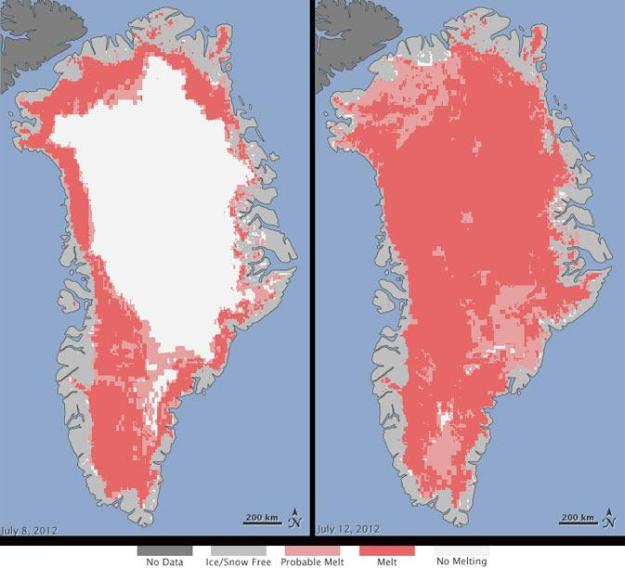
All but three percent of Greenland’s ice sheet has thawed, an event that has stunned scientists due to the rapid change over such a wide area, according to NASA. The near-complete melting is not unprecedented, but may mark a turning point in the Earth’s warming pattern.
On July 8, three NASA satellites recorded that about 40 percent of Greenland’s ice sheet had thawed. By July 12 — four days later — a staggering 97 percent of the ice had melted or thawed. Melting even occurred at Summit station, the highest and coldest place in Greenland, which has not happened since 1889. Scientists expect such an event to occur every 150 years. But over the past three decades, only about 55 percent of the Greenland ice sheet has thawed to this extent.
“This was so extraordinary that at first I questioned the result: was this real or was it due to a data error?” said Son Nghiem, a researcher from NASA’s Jet Propulsion Labratory in Pasadena, California, who analyzed the data from NASA’s Oceanstat-2 satellite.
“The Greenland ice sheet is a vast area with a varied history of change. This event, combined with other natural but uncommon phenomena, such as the large calving event last week on Petermann Glacier, are part of a complex story,” said Tom Wagner, NASA’s cryosphere program manager in Washington. “Satellite observations are helping us understand how events like these may relate to one another as well as to the broader climate system.”
Lora Koenig, a glaciologist at NASA’s Goddard Space Flight Center in Greenbelt, Maryland, says that the melting pattern is “right on time,” based on ice core samples analyzed by Dartmouth College researchers, but that, “if we continue to observe melting events like this in upcoming years, it will be worrisome.”
The melting was apparently due to a stream of extremely warm air that washed over Greenland. Ohio State University “ice scientist” Jason Box tells Time that “all the locals were talking about how sunny it was” during the period when the ice melted.
So, like most events related to climate change, the Greenland thaw is simply another major event that needs far more review and context to understand its significance. That said, there is far more evidence than just this easy-to-grasp event that point to overall global warming. As Bill McKibben reports in Rolling Stone, temperatures in June broke or tied 3,215 high-temperature records in the U.S. Drought levels in the U.S. are higher than they’ve been since the Dust Bowl of the 1930s. Wild fires and extreme weather have rocked much of the country — and the world. And the global temperature has been higher than the 20th century average for 327 consecutive months. In short: It’s getting hot in here.


